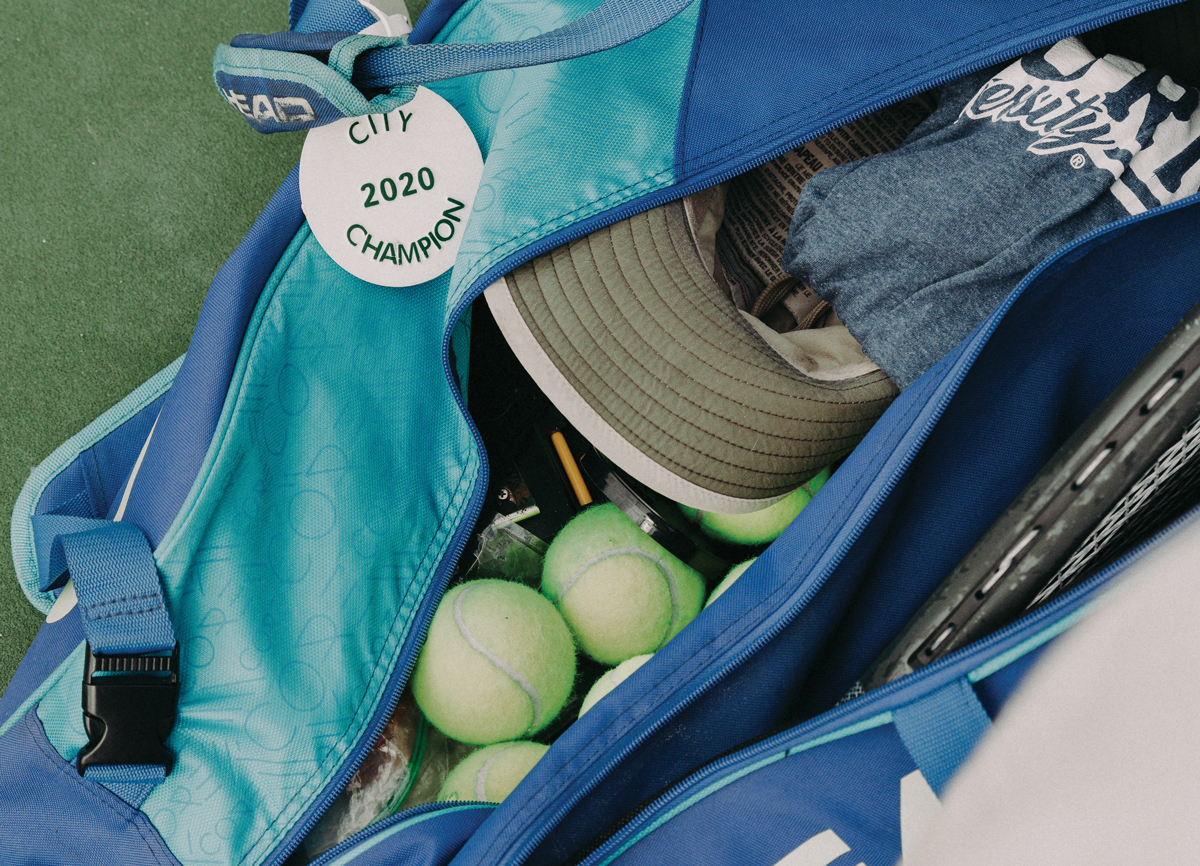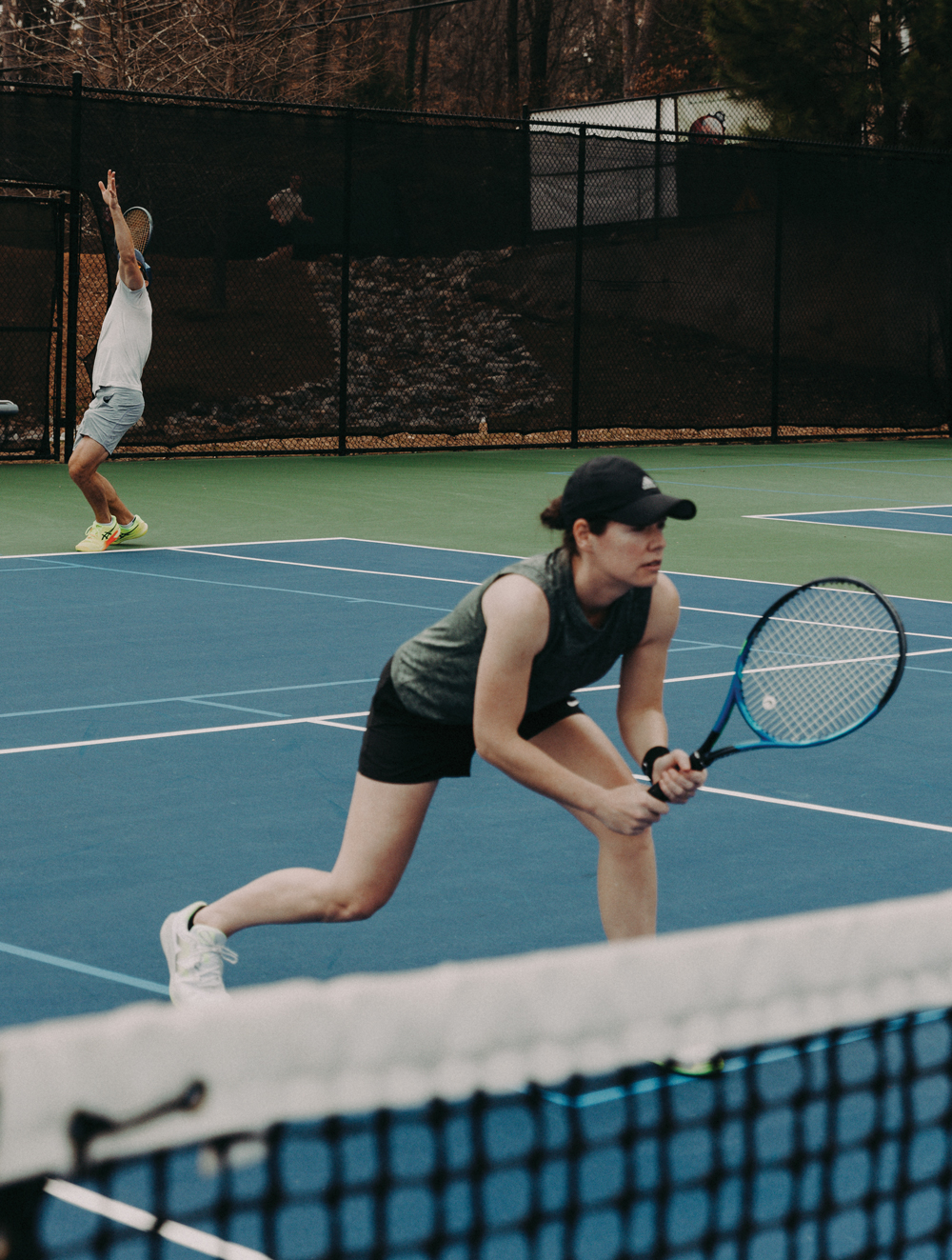

Photograph by Growl Bros.
John Hanna used to know if his father had won his Saturday morning tennis match the minute he got home from playing. A big grin on his dad’s face meant a victory and a fun day ahead. A stern expression, however, was an indication that it had not been a good time on the courts. Yet, regardless of the outcome, another match and opportunity always loomed ahead the following week.
Eventually, Hanna would join his dad as a weekend warrior playing tennis on Saturdays, a tradition more common in Atlanta than anywhere else. Atlanta is widely acknowledged as the tennis capital of the world, with more than 100,000 players throughout the metro area in leagues such as the Atlanta Lawn Tennis Association (ALTA) and USTA Atlanta. It’s near impossible to get an exact number, with those participating in junior tennis, high school, and college teams, as well as those who play independently or in private clubs, adding to the tennis craze.
As his father used to, Hanna plays the sport, and he works in it professionally. He’s the local go-to man for tennis information, most significantly as the longtime publisher of ALTA’s bimonthly Net News magazine. Hanna credits Atlanta’s agreeable weather—allowing for year-round play—coupled with an abundance of leagues and public venues, especially neighborhood courts, with the city’s tennis obsession.
The biggest league of its kind in the country, ALTA officially began in 1934 with tournaments and single competitions. Then, in 1971, the incoming ALTA president, Charlie Cox, envisioned an amateur league—and the doubles-only format began. According to Hanna, close to 1,000 people convened to play and spectate at the now-closed Squire Inn in Midtown for the first such event. “It was neighborhood versus neighborhood, the Hatfields versus the McCoys,” he says. “It mushroomed and grew.”
ALTA was one of the first recreational tennis leagues to develop in a major city. In 1975, the league had 10,000 members. By 1992, there were 71,000. In many ways, the league has connected Atlantans, with anyone able to participate and players meeting across the metro area for tennis. On any given weekend, an Atlanta icon could be on the other side of the net, such as home run king Hank Aaron or former U.N. ambassador Andrew Young, who both played ALTA during the ’90s.

Photograph by Growl Bros.
Current membership is between 65,000 and 70,000, and Atlanta now has approximately 3,000 ALTA-approved clubs and neighborhood facilities for players. The organization has grown to accommodate 28 levels of play, ranging from AA1 to AA4 (advanced), A (high), B (intermediate), and C (low intermediates and beginners), with matches taking place in the spring and fall. Hanna is still trying to play at AA1, but at 57 years old, it’s a grind, he laughs. Since league play is on a team level and not an individual one, Hanna has played on ALTA teams with Wimbledon champions, such as Atlantans Donald Johnson and Stephen Haas.
Darren Potkey, the executive director of USTA Georgia and The Georgia Tennis Foundation and the curator of The Sessions Family Georgia Tennis Hall of Fame and Museum in Marietta, says that Atlanta was instrumental in fueling the nationwide popularity of tennis in the ’70s. Many trends for recreational leagues started with ALTA and trickled their way around the nation.
When he moved to Atlanta from California 11 years ago, Potkey was amazed at all the neighborhood courts he found. “It wasn’t just two court facilities, but in some cases 4 to 6 to 10, and these facilities were very well taken care of,” he says.
According to ALTA marketing director Emmy Powell, more than 60 percent of ALTA teams are formed in neighborhoods. “Back in the ’70s and ’80s with the housing boom and the construction of swim and tennis clubs in Atlanta, you’d move into a neighborhood, and people were knocking on your door asking if you played tennis,” says Powell. Even if the answer was no, residents were nonetheless recruited to join the roster.

Photograph by Growl Bros.
For many players, an ALTA tennis match is high stakes, a competitive affair with the eventual goal of winning a division, which comes with a coveted bag tag and a spot in the city championships. “To win [a bag tag] is an accomplishment that has to be earned,” says Hanna. For others, the match is more of a social event, a nice balance of recreation and socialization with friends, with a lunch provided by the hosts, which can be simple snacks or—in some cases—a lavish, catered country club meal.
Tennis is an intergenerational sport, and ALTA brings in people of all ages and skill sets, according to Rita Maloof, the league’s president. Juniors can play at the age of seven, and senior leagues (45+ and 55+) are available too. Maloof even knows of a 92-year-old ALTA member. Family members often play together, but the league is also a great way to meet people. “We connect people from all over, and that is how ALTA has grown and helped grow tennis in Atlanta,” says Maloof. “We help bring in new people, and once they play ALTA, they don’t leave. They make lifelong friends.”
USTA Atlanta, the local branch of the national governing body of tennis, has also accelerated the growth of the sport, running the largest USTA leagues and USTA Jr. Team Tennis league programs in the country. The organization began in 1980 and focuses mostly on winter and summer leagues, combining two lines of singles play and three lines of doubles. Amy O’Connell, the executive director of USTA Atlanta, estimates more than 50,000 area players are members.
Any mention of Atlanta tennis history has to include Bryan Morel “Bitsy” Grant Jr., who was inducted into the International Tennis Hall of Fame in 1972 and won three U.S. Clay Court Championships, the precursor to the U.S. Open. “He is a folk legend here,” says Potkey. “Everyone seems to have known and met him.”
Named in his honor, Bitsy Grant Tennis Center was the first major tennis center in Georgia and is still the largest venue in the city, with 28 courts accessible to the public, almost half of them hard-to-find clay. Hanna recalls as a kid watching Grant and Georgia Tech football legend Bobby Dodd playing on those courts—and feeling very intimidated. Arthur Ashe and Bobby Riggs also played at the facility during their tennis careers.

Photograph by Growl Bros.
Over the years, Atlanta’s love has resulted in the city hosting several high-profile tennis events. A Federation Cup event was held here in 1990 at the Peachtree World of Tennis, with a U.S. squad including Jennifer Capriati and Zina Garrison taking the title, and a Davis Cup in 1998, where Jim Courier erased a set and a break lead to beat Marat Safin. World TeamTennis events have also been a part of the city’s tennis history. Martina Navratilova was part of the WTT Atlanta Thunder from 1991 to 1992 and lived here during the summers; Bjorn Borg was a member in 1994.
Various professional tennis tournaments have also occurred here, the latest being the Atlanta Open, which began in 2010 and shut down last year. One rap on the city has always been that Atlantans would rather play tennis than watch it. Hanna disputes the notion. He feels that scheduling and a lack of marquee players have hurt local tournaments. “In my mind, Atlanta is an arrogant tennis market,” he says. “We want to see the best. If the U.S. Open were in Atlanta, it would be crazy.”
Several professional players have also called Atlanta home. Coco Gauff, the 2023 U.S. Open champion, grew up here, as did 2024 Wimbledon doubles champion Taylor Townsend. Christopher Eubanks, the 2023 Wimbledon quarterfinalist, is from south Atlanta, and 2005 U.S. Open semifinalist Robby Ginepri lives in Acworth and is the director of tennis programming at the Olde Towne Athletic Club in Marietta. Melanie Oudin, who won the 2011 U.S. Open mixed doubles title, played in ALTA while she was growing up.
Despite the number of people in the city and the opportunities available, there was something of a malaise in the late 2010s, according to Hanna. “There wasn’t that much exciting going on,” he says. “So much of tennis popularity is tied to the superstars of the men’s and women’s tour. We had the golden age of tennis with Federer, Nadal, and Djokovic, but the last American men’s champion was back with Roddick in 2003.”
Locally, tennis continues to thrive, in part thanks to the effects of the Covid-19 pandemic. At first, panic set in when spring leagues were shut down in the spring of 2020. “ALTA was scared. USTA was scared,” recalls Hanna. But a few months later, the Centers for Disease Control and Prevention named tennis as one of the safest sports to do while social distancing, and suddenly popularity went straight up. “Products sales went through the roof, and people were playing in the streets and driveways and parks, wherever they could find a court or a flat place,” says Hanna. “At least in Atlanta, it was a pathway for people to progress if they chose to play. Because of ALTA, there was a place for them to go.”
Another threat turned asset is pickleball, which has seen explosive growth in the past five years. Rather than fear it as a competitor, tennis leagues have learned to embrace it. In 2023, ALTA introduced pickleball leagues, which drew 4,000 registered players; that number doubled by 2024, says Powell. USTA also has pickleball leagues. Purists have been annoyed that venues have replaced some tennis courts with pickleball ones, but Hanna believes there is a way both can coexist as racket sports. Maloof calls pickleball a more social sport and one that doesn’t take as long to play.
ALTA and USTA could be perceived as competitors but have done an effective job of recognizing each other’s existence and strengths, says Potkey. “The USTA adult leagues in Atlanta are the largest in the country, and one of the main reasons is because of ALTA,” he says. “They do an amazing job of formulating and perpetuating tennis culture in the city. The leagues help each other.”
Both organizations are constantly looking to offer more. ALTA recently started a pilot program to extend its reach and is trying to appeal to a younger crowd. USTA Atlanta works with other local organizations throughout the year, such as the Atlanta Team Tennis Association (ATTA), and offers a singles league as well as programs for athletes with special needs. Just shy of 600 novice players went through USTA Atlanta’s Tennis Apprentice program in 2024 to learn the sport, and the pipeline of new players is strong.
O’Connell has been buoyed by the steady rise in players since the pandemic. “More people are playing in 2024 than [they have] in years and years,” she says. “It’s an exciting time now.”
Susan Bacher lived in Atlanta from 1991 to 2016. During that time, she played ALTA on and off for 20 years, as well as USTA, ATTA, and K-Swiss. She enjoyed the competitive aspect as well as the social one. “The full afternoon experience with friends was amazing,” she says. “These are some of my lifetime best friends also.” Now that she’s moved away from Atlanta, however, tennis is not the same experience. “I and others from my former team have tried it in other cities, and it is not the same. I miss it so much . . . more than I miss playing.”
This article appears in our April 2025 issue.
Advertisement







